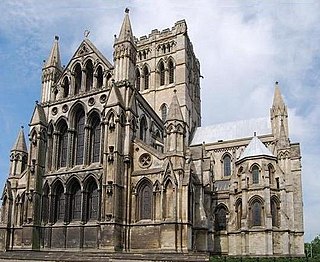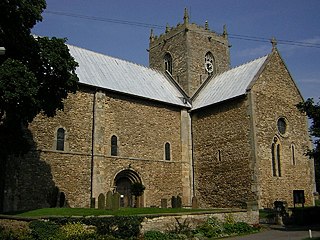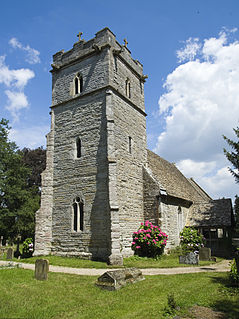
A church building or church house, often simply called a church, is a building used for Christian religious activities, particularly for Christian worship services. The term is often used by Christians to refer to the physical buildings where they worship, but it is sometimes used to refer to buildings of other religions. In traditional Christian architecture, a church interior is often structured in the shape of a Christian cross. When viewed from plan view the vertical beam of the cross is represented by the center aisle and seating while the horizontal beam and junction of the cross is formed by the bema and altar.

A primary school, junior school or elementary school is a school for children from about four to eleven years old, in which they receive primary or elementary education. It can refer to both the physical structure (buildings) and the organisation. Typically it comes after preschool, and before secondary school.

Christ Church Cathedral, more formally The Cathedral of the Holy Trinity, is the cathedral of the United Dioceses of Dublin and Glendalough and the cathedral of the ecclesiastical province of the United Provinces of Dublin and Cashel in the (Anglican) Church of Ireland. It is situated in Dublin, Ireland, and is the elder of the capital city's two medieval cathedrals, the other being St Patrick's Cathedral.
The pattern of local government in England is complex, with the distribution of functions varying according to the local arrangements.

In England, a civil parish is a type of administrative parish used for local government, they are a territorial designation which is the lowest tier of local government below districts and counties, or their combined form, the unitary authority. Civil parishes can trace their origin to the ancient system of ecclesiastical parishes which historically played a role in both civil and ecclesiastical administration; civil and religious parishes were formally split into two types in the 19th century and are now entirely separate. The unit was devised and rolled out across England in the 1860s.

Lancaster Cathedral, also known as The Cathedral Church of St Peter and Saint Peter's Cathedral, is in St Peter's Road, Lancaster, Lancashire, England. It was a Roman Catholic parish church until 1924, when it was elevated to the status of a cathedral. It started as a mission church in 1798, and the present church was built on a different site in 1857–59. It was designed by E. G. Paley in the Gothic Revival style. In 1901 a baptistry was added by Austin and Paley, and the east end was reordered in 1995 by Francis Roberts. The cathedral is in active use, arranging services, concerts and other events, and is open to visitors. The building is recorded in the National Heritage List for England as a designated Grade II* listed building.

Manchester Cathedral, formally the Cathedral and Collegiate Church of St Mary, St Denys and St George, in Manchester, England, is the mother church of the Anglican Diocese of Manchester, seat of the Bishop of Manchester and the city's parish church. It is on Victoria Street in Manchester city centre.

The Cathedral Church of St John the Baptist is the Roman Catholic cathedral of the city of Norwich, Norfolk, England.
St Margaret Lothbury is a Church of England parish church in the City of London; it spans the boundary between Coleman Street Ward and Broad Street Ward. Recorded since the 12th century, the church was destroyed in the Great Fire of London in 1666 and rebuilt by the office of Sir Christopher Wren. St Margaret Lothbury still serves as a parish church, as well as being the official church of five Livery Companies, two Ward Clubs and two Professional Institutes. It also has connections with many local finance houses, all of which hold special services each year.

Audley is a rural village approximately four miles north west of the town of Newcastle-under-Lyme in Staffordshire, England. It is the centre of Audley Rural parish.

The Minster Church of St Mary, Stow in Lindsey, is a major Anglo-Saxon church in Lincolnshire. It is one of the oldest parish church buildings in England. It has been claimed that the Minster originally served as the cathedral church of the diocese of Lindsey, founded in the 7th century.
The question of the properties and finances of the Church of England has been publicly raised in recent years because of the declining number of regular parishioners in the United Kingdom who cannot continue to finance the large amount of real estate controlled by the church.

Trinity Cathedral is a historic church on Euclid Avenue at East 22nd Street in Cleveland, Ohio. It is the cathedral of the Episcopal Diocese of Ohio.

Greater Manchester is a metropolitan county in North West England. It was created by the Local Government Act 1972, and consists of the metropolitan boroughs of Bolton, Bury, Oldham, Rochdale, Stockport, Tameside, Trafford, Wigan and the cities of Manchester and Salford. This is a complete list of the Grade I listed churches in the metropolitan county as recorded in the National Heritage List for England. Buildings are listed by the Secretary of State for Culture, Media and Sport on the recommendation of English Heritage. Grade I listed buildings are defined as being of "exceptional interest, sometimes considered to be internationally important"; only 2.5 per cent of listed buildings are included in this grade.

The Church of Our Lady of the Assumption and St. Gregory is a Roman Catholic church on Warwick Street, Westminster. It was formerly known as the Royal Bavarian Chapel, since like several Roman Catholic churches in London it has its origin in a chapel within a foreign embassy. It was built between 1789 and 1790 to the designs of Joseph Bonomi the Elder. The only surviving eighteenth century Roman Catholic chapel in London, it is a Grade II* listed building.

Meadrow Unitarian Chapel is a Unitarian chapel in the Farncombe area of Godalming, Surrey, England. It is part of the London District and South Eastern Provincial Assembly of Unitarian and Free Christian Churches, one of 16 districts within the General Assembly of Unitarian and Free Christian Churches, the umbrella organisation for British Unitarians.

The Church of St Andrew is a Church of England parish church in Rugby, Warwickshire. It is a Grade II* listed building. As a large church that is not a cathedral, it is part of the Greater Churches Network.

Blackheath Quaker Meeting House is a Grade II listed building in the London Borough of Lewisham. It has been the home of Blackheath Quaker Meeting since 1972, and is also used by many community groups. Designed by Trevor Dannatt, it is believed to be the only Quaker Meeting House in Britain built in the Brutalist style. In the survey of Quaker meeting houses conducted by the Architectural History Practice for Historic England and Quakers in Britain it was described as a "Brutalist jewel" and "of exceptional aesthetic value".





















